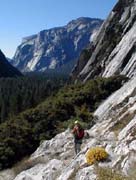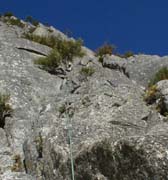In Yosemite Valley the first technical rock climbing route was on Washington Column. In September of 1933 a group of four climbers brought ropes and pitons to the valley and put up a climb in the crease between the gray granite of Washington Column and the whiter rock of Royal Arches. They named their route Lunch Ledge. Steve Roper's 1971 Climber's Guide to Yosemite Valley rates it 5.6 and describes about 6 pitches of climbing. He adds that it was once the most popular climb in the valley but that its popularity has waned recently with the discovery of more enjoyable routes.
My friends, Hal Murray and Bob Ayers have climbed it many times and use it as an introduction to Yosemite for many young climbers. Over the years they have developed the "lunch ledge constant." That a trip to lunch ledge will take 1 hour for every person included in the trip. 5 people take 5 hours, 2 people take 2 hours.
So, when Joe Hastings and I, Paul Doherty, were looking for a moderate length warm up climb we chose Lunch Ledge. We hoped to avoid crowds. We parked near the Ahwanee Hotel and walked along the trail at the base of Royal Arches until we were below the base of Washington Column. We found a very faint trail leading up slope and followed it to the base of the rock. A huge 3 rd class ledge ledge led from the left up to the base of the climbing 200 feet above us. We started up the ledge at 2 PM and climbed 3rd class with a few entertaining bits to the rope-up spot.
Joe asked what 3rd class meant exactly, I gave him Joe Kelsey's famous description that the difference between class 2 and 3rd class climbing is that a dog can climb class 2 but not class 3. I added that if experienced climbers tie into a rope and put in protection only at the belays it becomes 4th class. I was interested to note that in Hervey Voge's 1954 Climber's Guide to the High Sierra the route is called 4'th class!

I took the first lead, down and right around the bottom of a left facing corner. Vegetation growing in the cracks showed that this route wasn't climbed very often, pin scars in the same cracks showed that it had been popular in the era of piton protection, and that many climbers hadn't agreed with the 4'th class rating given the route by its first ascent party, they had added protection between belays. After rounding the corner I came to a tree wrapped with slings and a rappel ring it is part of the descent route. However I continued up with some rope drag to the next sling-wrapped tree. The guidebook said, "traverse upward and rightward to a large ledge." I assumed that we went out this ledge, I assumed wrong!
I sent Joe on lead up and out this ledge to a large pine tree. The route above was supposed to be 4'th class but above us rose a steep smooth wall split by a beautiful crack. We wondered how hard the crack was, 5.7,5.8, 5.10? I began to lead the bottom and found that the first moves were 5.8 it looked good as far as I could see above, but I couldn't see all the way to the top. Since I knew I was not on 4'th class and so off the route we had come to climb, I decided to return down the ledge to rejoin the correct route.
Checking the guidebook later I found that the crack was on the route "Lunch Ledge Direct" put up in 1961 by Yvon Chouinard and Wally Reed. I noticed that they nailed up the crack I had started to climb. In a modern guidebook the crack has become part of the free route "Power Failure" and is considered to be a 5.8 hand crack.
Once back on the route, Joe climbed up to the forked tree and belayed.

Next I led up and right around a bulge to 4'th class climbing over steps to another large pine tree. There was a fine view of the valley from this pine tree ledge.
Joe continued up cracks and chimneys until we could see a traverse left to the base of the obvious crack called the Reigelhuth Chimney. I traversed over to the base of the chimney where I belayed to a three bolt anchor of a rappel highway.
The next bit was awkward, I made a move up and clipped a bolt then felt around for a move. I couldn't find the way up. This was hard 5.6. Talking to Bob Ayers later he said that he chimneyed this portion up the wide flare, and that Hal fist jammed over the ceiling. At the time I was there, I saw and rejected the chimney move and didn't see the fist jam because it was buried in dirt and vegetation. I excavated a dead dry thistle which fought back by piercing me with many spines. Then continued to dig up leaves and dirt which had piled up in the crack behind the thistle. At last holds appeared. I munged up over the lip to better holds in the clean crack above. The rest of the crack up to Lunch Ledge itself was fun fifth-class climbing, featuring nice jams and laybacks. We reached the top by 5 PM adding an hour to the lunch ledge constant due to our 2 pitch detour.
We used 2 ropes to rap the route. There really was a rappel highway with two or three bolt anchors and rap rings at every rap station. At the bottom we decided to skip the highway and went straight down to the ground adding one 30 foot rappel off a tree to reach flat walking ground. It was 6:20 the sun had set and it was getting dim.
From the thistle growing on the last pitch I don't think anyone else had climbed the route during the year 2000. How things have changed since 1954 when the guidebook declared Lunch Ledge to be the most popular roped climb in Yosemite! So if you want to get away from the crowds, relive a bit of Yosemite history, and don't mind a few bushes on your route. Give Lunch Ledge a try. I'm planning to go back to climb that 5.8 hand crack myself.
|
Scientific Explorations with Paul Doherty |
|
30 Oct 2000 |